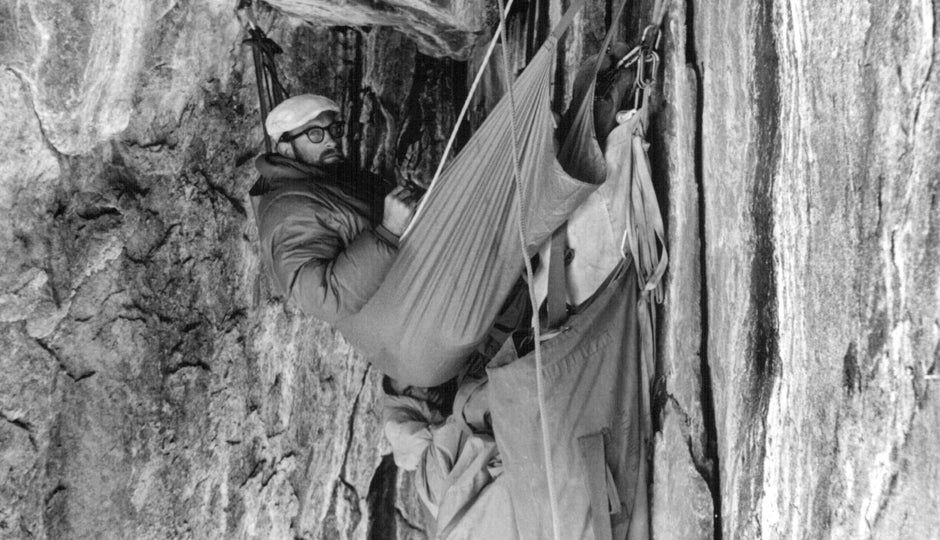Royal Robbins: A Timeline and a Bibliography

"None"

1952: First free ascent of Open Book (5.9) at Tahquitz Rock, California. At 17 years old, Robbins broke into new free-climbing territory to establish the first 5.9 in the country. The grade was given some time after the ascent—at the time, 5.9 was the upper limit of the Yosemite Decimal System. Robbins led the 300-foot route in tennis shoes.
1957: First ascent of the 2,000-foot Northwest Face of Half Dome (VI 5.9 A1) in five days with Mike Sherrick and Jerry Gallwas. As the first grade VI climb established in the United States, this ascent paved the way for multi-day big-wall ascents to come. It was the first time anyone had climbed something so sheer, tall, and committing in North America.
1960: Second ascent/first continuous ascent of the Nose (VI 5.9 C2) on El Capitan in one week with Joe Fitschen, Chuck Pratt, and Tom Frost. Warren Harding’s first ascent in 1958 took 45 days over the course of a year and a half.
1961: First ascent of Salathé Wall (VI 5.9 C2) on El Capitan with Tom Frost and Chuck Pratt. The team used only 13 expansion bolts, including at belays, as compared to the 125 Harding placed on the Nose. A year later, Robbins and Frost made the first continuous ascent of the route in five days.
1962: First ascent of American Direct, Aiguille du Dru, Mont Blanc Range, France, with Gary Hemming. This alpine route is considered a classic, though recent rockfall has rendered it unclimbable.
1964: First ascent of North America Wall (VI 5.8 C3) on El Capitan with Tom Frost, Chuck Pratt, and Yvon Chouinard. At the time, this was considered the hardest big-wall climb in the world. The team used no fixed lines, minimizing the opportunity for retreat and pioneering a bold approach to wall climbing. They completed the route in a continuous 10-day push.

1964: First free ascent of Athlete’s Feat (5.11-), Castle Rock, Boulder, Colorado, with Pat Ament. At the time, the pitch was graded 5.10; it’s since had two bolts added to the crux first pitch and is now considered 5.11, making it one of the first in the United States. Robbins led the first pitch, characterized by thin face and slab climbing over a dangerous granite ledge/spike, with, wrote Ament, “only a scary-looking Bugaboo piton” for protection.
1967: First ascent of Nutcracker (5.8) in Yosemite. The route is entirely nut protected; this technique, inspired by a visit Robbins had made to the United Kingdom, was pivotal in establishing Robbins’ and others’ principles of “clean climbing”—using easily removable, passive protection instead of pitons, which with repeated hammering and removal had been scarring Yosemite’s cracks. Considered a Yosemite classic, Nutcracker is very popular today.
1968: Roped solo of the Muir Wall (VI 5.9 A4) on El Capitan—the first solo climb of the 3,000-foot massif and of a VI. Robbins spent 10 days alone on the route, which had been established three years prior by T.M. Herbert and Yvon Chouinard. The wall had been named for early Sierra climber, author, and prervationist John Muir, whose advocacy inspired Robbins’ strict, minimalist approach to climbing. In his “Alone on the John Muir Wall” essay in the 1969 American Alpine Journal, Robbins wrote, “But what is this solo nonsense, anyway? Oh, just solo nonsense. Just another way to prove something. A sort of spiritual onanism. The thing about a solo climb is that it is all yours. You are not forced to share it. It’s naked. Raw. The fullest expression of the climbing egoist. It is also a way of exploring oneself. A solo climb is like a big mirror. One is looking at oneself all the way up.”
1980–1982: The Triple Crown of first descents. Along with Doug Tompkins and Reg Lake, Robbins paddled three of the few remaining whitewater kayaking first descents in the Sierra Nevada. Their six-day descent of the Middle Fork of the San Joaquin River in 1980 was a grueling expedition of climbing, portaging, and paddling on a limited food supply. The next year, the self-named “Billy Goat Crew” tackled the Kern River—a remote descent that required the team to haul boats and gear over treacherous, high-altitude terrain on the shoulder of Mt. Whitney. Robbins, Lake, and Tompkins completed the Crown in 1982 with their descent of the Middle Fork of the Kings River, notorious for its steep gradient and perilous rapids.

Other notable ascents:
- 1964: FA of the North Face of Mt. Hooker in the Wind River Range (wilderness VI 5.10 A4)
- 1964: FA of Danse Macabre on Devils Tower, Wyoming (5.10d)
- 1969: FA of Tis-Sa-Ack on Half Dome (VI 5.10 A4)
- 1970: FA of Arcturus, Half Dome (VI 5.7 A4)
- 1971: Second ascent of the Wall of Morning Light (a.k.a. the Dawn Wall)
Publications:
- Basic Rockcraft, 1971
- Advanced Rockcraft, 1973
- My Life, Volume One: To Be Brave, 2009
- My Life, Volume Two: Fail Falling, 2010
- My Life, Volume Three: The Golden Age, 2012
- (See also, Royal Robbins: Spirit of the Age, the excellent biography by Pat Ament, 1998)